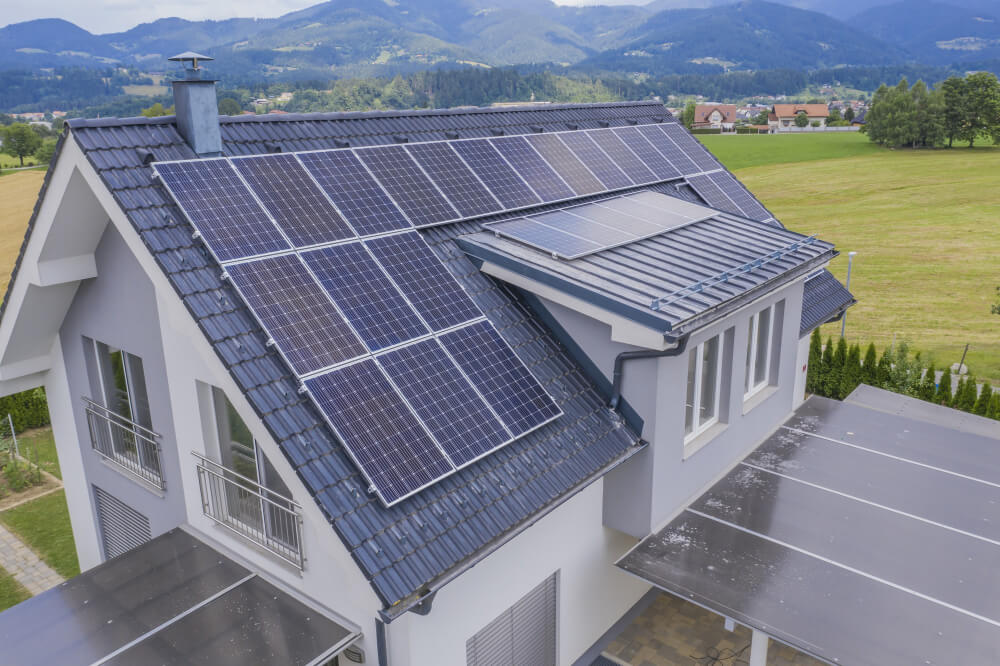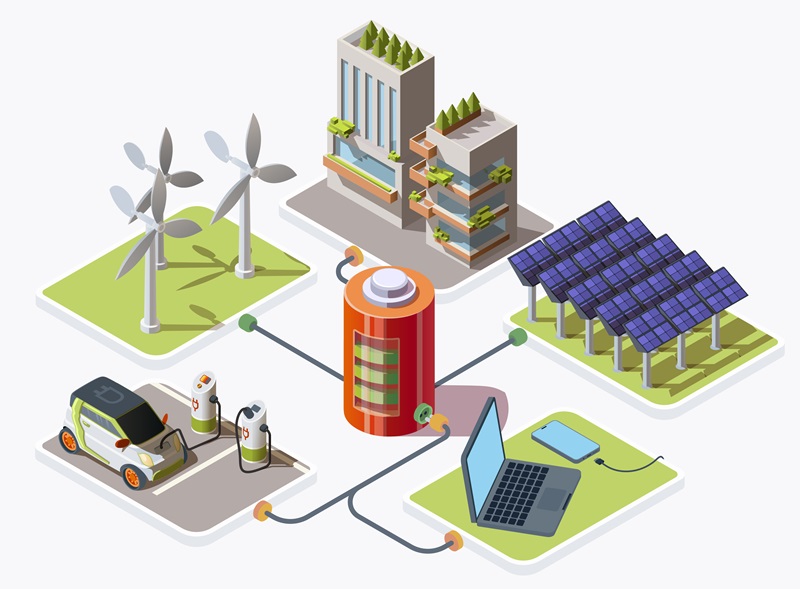Over the past few years, solar energy has come a long way in the United States. With the rising climate crisis, it is expected to remain the driving force behind the transition towards cleaner energy. Also, favorable laws and regulations and technological advancements have fueled this trend.
According to a report by the Energy Information Administration (EIA), the U.S. will produce 14% more electricity from solar in 2024. In fact, the manufacturing capacity of solar photovoltaic systems is forecast to reach approximately 1000 GW in 2024 globally.
So, it is very obvious to say that the future of solar energy looks promising. But to what extent? And how is solar technology playing a part in it?
To answer these questions, let’s delve deeper into the latest solar trends and innovations and get to know what the future holds for the solar industry.
So, without further ado, let’s get started!
The rising solar trends and innovations in 2024
Rooftop solar panels

The existence of solar panels in commercial areas has been around for a long time. However, what’s interesting is the rapid shift of Americans towards the residential rooftop solar panel system.
As per the Statista report, residential PV installations reached nearly 3.6 million at the end of 2022 and are still rising exponentially. Not just that, residential installations account for 20% of the total solar power installed in the United States.
Well, if you consider the immense benefits that come along with solar installations, you won’t be surprised. Installing panels on a property helps homeowners significantly cut their power bills, supports the environment by reducing carbon emissions, and reduces energy dependency on local utility providers.
And if states provide some additional incentives and rebate programs, they can further save on their solar projects and enjoy more savings. In short, with the installation of solar panels, everyone’s future is bright and efficient, which makes it a hot trend in the market for solar energy.
Continuous upgrades in solar panels efficiency
Another ongoing trend in solar is the continuous advancements in the efficiency of solar panels. Scientists and producers are pushing the envelope of what is feasible by creating solar panels that can generate more electricity from sunshine.
The efficiency of new materials, such as perovskite solar cells, is improving with great promise, opening up solar electricity for residential and commercial use at a lower cost.
The next example is the recently popular bifacial solar panels. Bifacial panels have the ability to produce power from both sides, in contrast to typical solar panels that can only collect light from one side.
These panels may greatly increase energy production by absorbing scattered and transmitted sunlight, which makes them perfect for a variety of uses, such as solar carports and ground-mounted systems.
Solar energy storage solutions

One of the growing solar energy trends and innovations that have been witnessed in the past few years is the use of solar batteries. The reason behind their growing popularity is that they can store the excess amount of solar electricity generated by the PV system during the day.
One can use this stored energy on days when the sun is not shining, during the night, and also in the event of power outages. Thus helping homeowners utilize the full potential of renewable energy and also being entirely energy independent.
Solar batteries on the market are available in four types, including lead-based, lithium-based, nickel-cadmium, and flow solar energy storage solutions. Among all these batteries, lead-based ones are the most widely used in the industrial and automobile sectors, as well as in residential areas, because of their affordability and higher efficiency.
You would be amazed to know that the global solar battery market size was $113.4 million in 2019 and is projected to reach nearly $360 million by the end of 2027. Needless to say, solar batteries hold great potential for everyone.
The rise of smart grid technology
The future of smart grids looks promising and is one of the latest and trending innovations in solar energy. So what is it? What’s its relationship with renewable energy?
Basically, smart grid technology is responsible for intelligently monitoring and managing energy demand and distribution across homes. The smart grid connects a range of dispersed energy resource assets to the power grid. The data further collected on the smart grid systems utilizes frequent self-assessments, and the IoT utilities are able to swiftly identify and address service issues.
This self-healing feature, which frees utilities from relying on consumers to report outages, is an essential part of the smart grid.
So, there is no denying that smart grid technology holds great potential for the future of solar energy. The study by Data Bridge Market Research says the same. According to their research, the smart grid market size was nearly $413 million in 2022 and is forecast to reach nearly $162848 million by the end of 2030.
Overall, this environmentally friendly smart grid technology, propelled by the desire for more sustainable methods and cleaner fuels globally, has the potential to transform the way electricity is distributed to consumers worldwide and revitalize economies that are in a state of stagnation.
Shifting towards off-grid solar system
The positive inclination towards the off-grid solar system has increased its market size from 9.13 gigawatts in 2024 to a projected 13.12 gigawatts in 2029, a CAGR of nearly 7%, making it one of the hottest renewable energy technology trends. Off-grid solar systems became popular for three reasons.
One is that they are connected to any local power grid, which means you are in charge of solar power production and consumption, thus making you self-sufficient on solar power.
The second is that it makes life possible with solar energy in rural areas where power distribution is not feasible remotely. And third, you can avail of the electricity even in power outages as long as you have it stored in the batteries.
Similar to the on-grid systems, the off-grid solar system also helps homeowners lower their power bills and contributes to the environment. The only difference here is that they make the residents energy independent and play a major role in the nation’s economy, which is why this solar energy technology is thriving in the market.
Expansion of communal solar power
Another interesting trend that is contributing to the future of solar energy is the expansion of community solar projects. Under this one, one gigantic solar panel is usually installed at an off-site location and distributes power to multiple homes, businesses, nonprofits, and others who can’t afford to go solar.
All the community solar subscribers pay for their share at the end of the month, more like a monthly subscription. It is very similar to the individual residential solar panel project.
It is an excellent alternative for those who can’t go solar because of either their financial problems, because they are tenants, or because they don’t have the optimal roof conditions for solar installation.
People are opting for community solar instead of going no solar at all. In fact, according to the forecast report by Wood Mackenzie, the community solar market will see a growth of 118% over the coming five years (from 2023 to 2028).
Huge, right!
Solar-powered wearable technology
Over the past few years, wearable technology has dominated the market with its portable and durable devices, from fitness trackers to smart watches. However, with the global climate crisis concern, one more thing has been brought into the limelight and is emerging as the latest solar energy technology: solar-powered wearable devices.
The technology uses miniature solar cells to convert the solar energy into electricity and further store it. The solar-powered wearable devices allow users to operate their devices continuously with a constant supply of electricity in the background without needing to repeatedly recharge.
Anyone can harness the power of solar energy on the go without carrying the need for power outlets while also contributing to the planet with an energy-efficient technology solution.
Some of the real-world applications of solar-paper-red wearable devices are health trackers, augmented reality (AR) glasses, and solar smartwatches.
Integration of AI in solar panels
One of the most revolutionary solar energy trends is the integration of artificial intelligence (AI) in managing solar energy in solar panel systems.
The AI algorithms help installers by optimizing the location of solar panels to install, forecasting the amount of energy the system produces, and boosting its overall efficiency. In fact, it is expected that more homeowners will embrace AI-powered technologies in solar panel installations in the coming future.
According to one report, the global market size of artificial intelligence in the renewable energy sector was $10 billion in 2022, and it is projected to reach nearly $114.87 billion by the end of 2032, a CAGR of around 27%. Seeing this, it is very evident that with technological advancements in solar energy, the future of solar looks very promising.
Final Words
Solar energy appears to have a bright and hopeful future. Technology advancements, more capacity for storage, decentralized systems, supportive federal and state policies and regulations, and the incorporation of artificial intelligence are putting the solar sector on a path toward sustainability and broad use.
But the road to a solar-powered future does not stop here. Keeping up with the latest developments and remaining educated will be essential as we traverse this revolutionary time to optimize solar energy’s advantages for people, companies, and communities.
We hope you found this blog informative and now have a brief idea of the latest solar trends and innovations in the market.
Do tell us in the comments section below if you have something else on your mind. We would be glad to know more about it.
